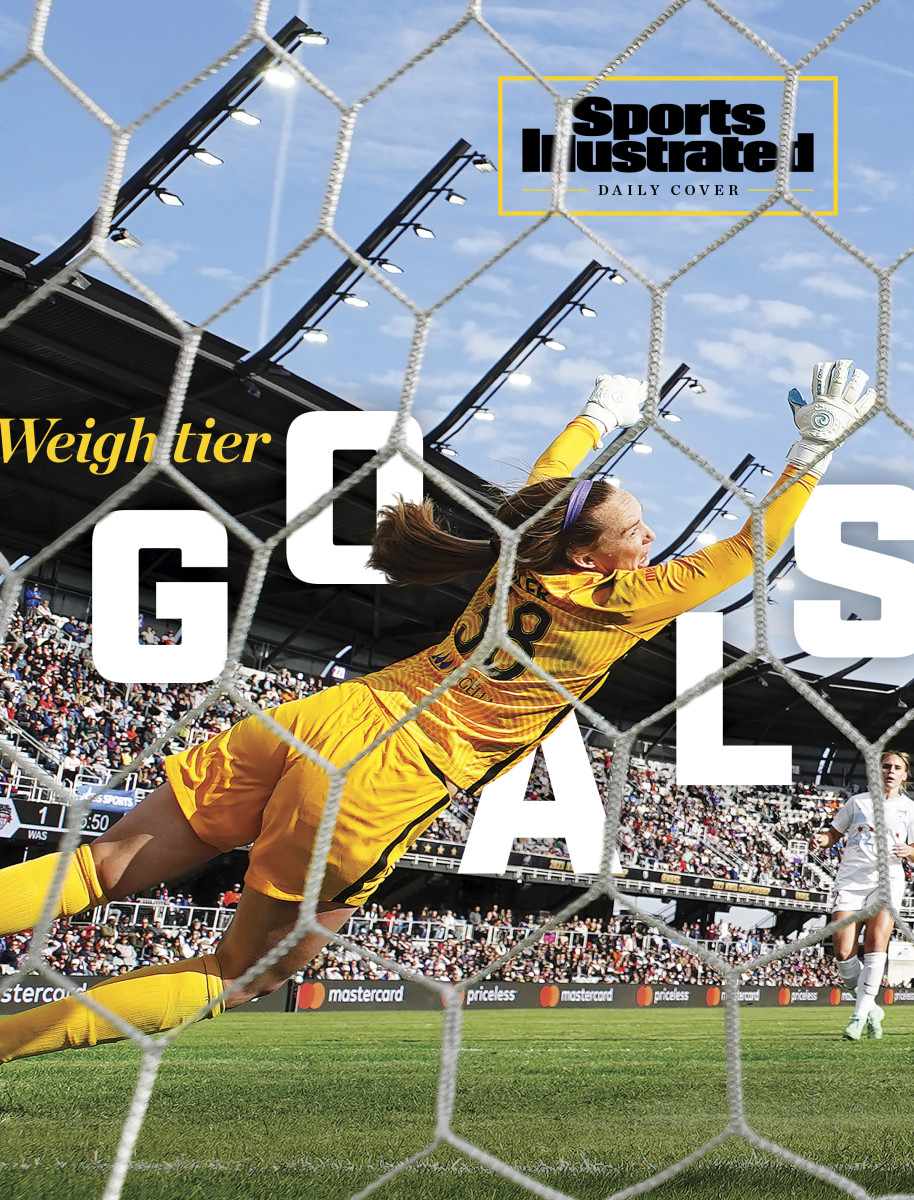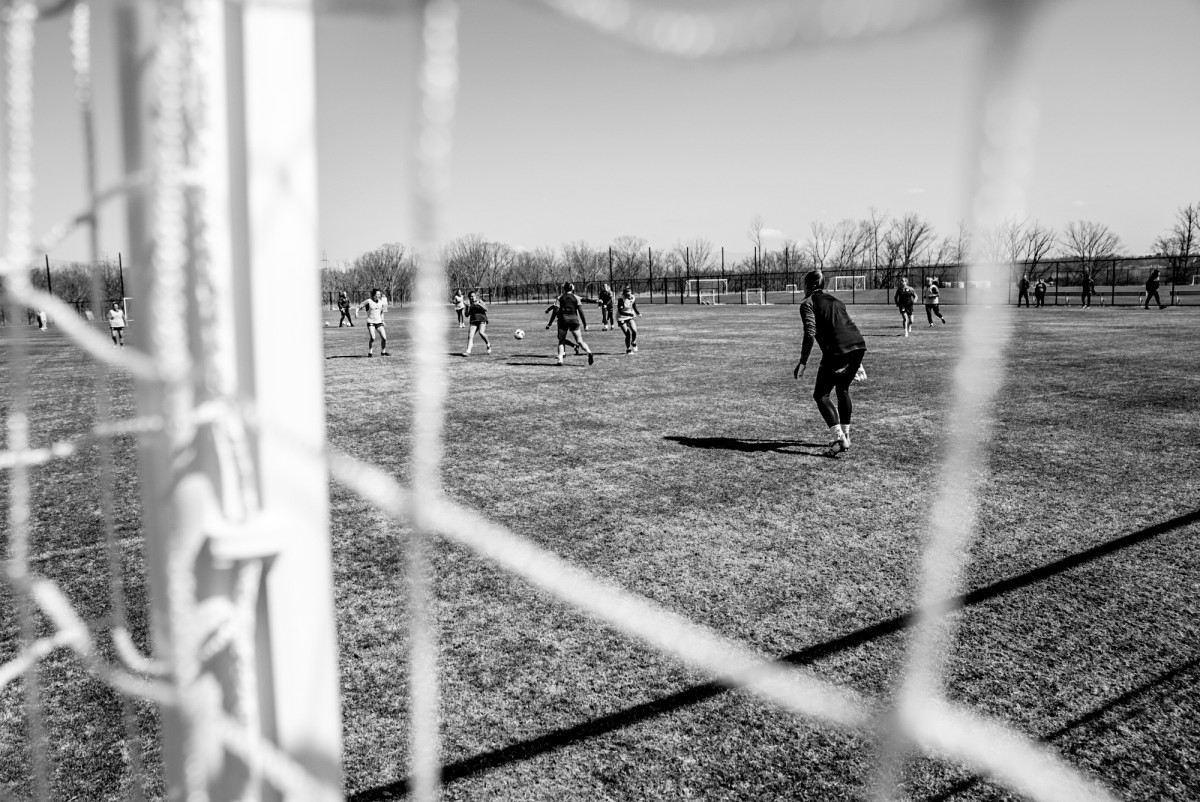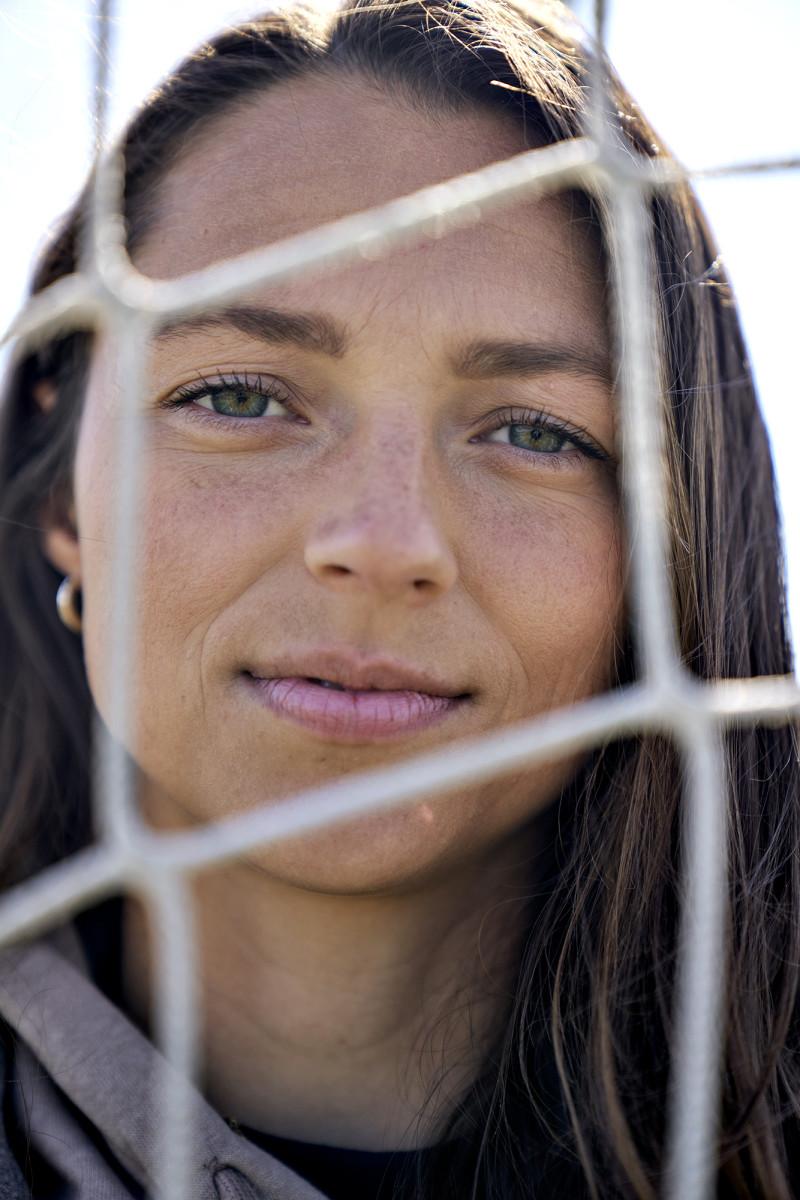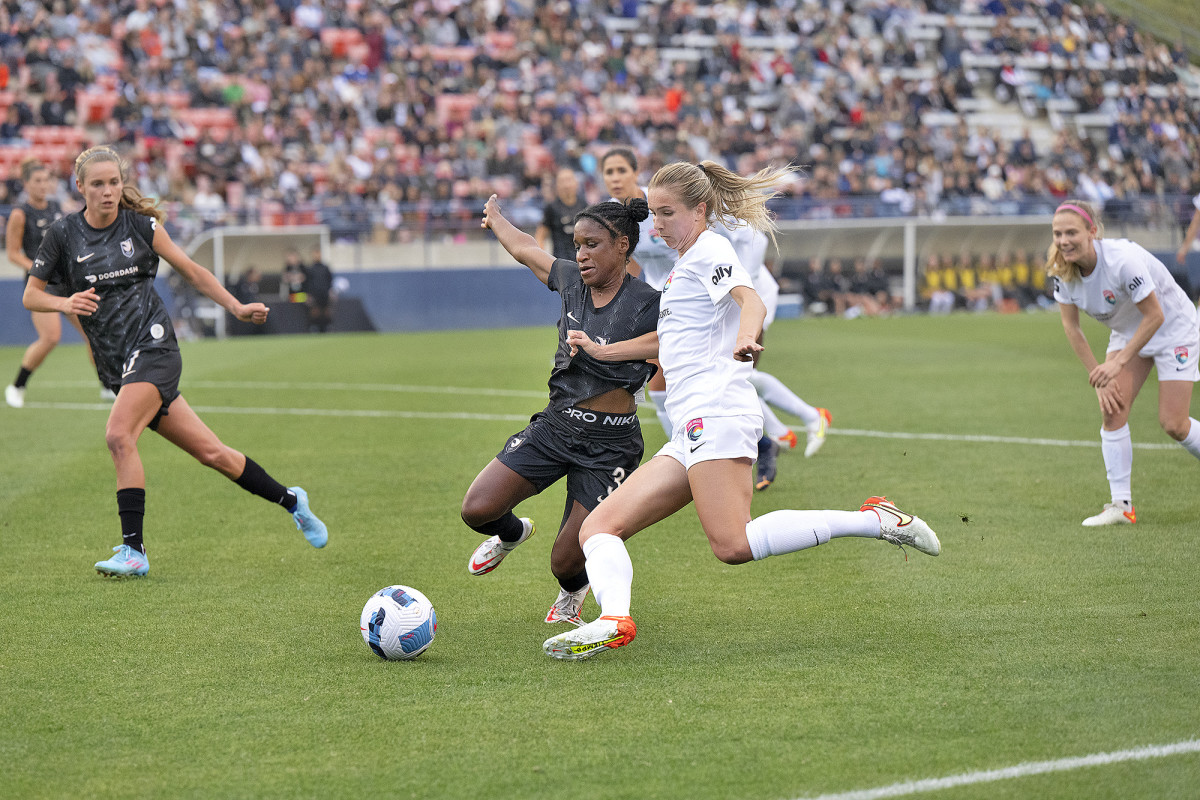The Spirit of the NWSL As It Turns 10
It’s hard for the Washington Spirit to find the language for what they experienced last season. After a roller-coaster playoff run, the club won the NWSL championship in November, securing victory with a header in extra time from U.S. women’s national team fixture Kelley O’Hara. A deep roster racked up awards: Forward Ashley Hatch led the league in scoring to win the Golden Boot, first-round draft pick Trinity Rodman became Rookie of the Year and veteran Aubrey Kingsbury (né Bledsoe) was named Goalkeeper of the Year. Their core talent jelled over the course of the season, and, with most of the group back, Washington is hopeful it can defend the title in 2022.
But that’s the part that’s easy to cover. It’s the rest that’s so difficult to describe.
The championship’s backdrop was a reckoning with abuse and harassment from leadership figures across the league. The Spirit’s coach was reassigned and ultimately fired after a Washington Post investigation shared accounts that he had verbally and emotionally abused players. The front office was accused of fostering a toxic culture. The players called for the team to be sold. Their most dedicated fans felt that they had no choice but to boycott. The season was a storybook journey for a championship, and it was also a prolonged, deeply painful mess.

“It was hard,” says midfielder Andi Sullivan. “Because it was such an exciting season, an amazing year, and it had to be overshadowed by a lot of negativity—well, not negativity, I’d say . . .”
The team captain searches for the right word.
“Truth,” she says, finally. “It was just the truth. And it was necessary to create change.”
It’s a swirl of emotion that is fitting not just for the team but for the league as a whole.
The NWSL has plenty to be excited about: This will be its 10th year—a milestone that none of its predecessor leagues ever got close to celebrating—and it’s courting new sponsors and expanding to fresh markets. The level of competition has risen as careers have become more sustainable and the experience has become more professional. In January, just before players reported to training camps, their union ratified its first collective bargaining agreement, which ushered in important changes such as the introduction of free agency.
NWSL SEASON PREVIEW: 10 Best Games in League History | Next Stars Under 25 | League Lifers
Yet that progress has not been able to stand out as the biggest recent story in the NWSL. Instead, the league is still navigating the fallout from last year, when players from multiple teams spoke out about verbal abuse, sexual harassment and unsafe training environments. A few had tried to voice complaints years before—only to realize their words had apparently been allowed to fall through the cracks and, in some cases, been actively covered up. But the moment quickly grew too big for anyone to ignore any longer. It was not just the Spirit, or the North Carolina Courage or the Portland Thorns or any other single club. The situation was not the work of a few isolated bad actors. It was something rooted far deeper.
After player demonstrations and canceled games, the U.S. Soccer Federation launched an independent probe of the league led by former U.S. deputy attorney general Sally Yates. The investigation is ongoing. Five coaches who were credibly accused of abuse last season either resigned or were fired and replaced. (A sixth has since been suspended.) Commissioner Lisa Baird and league general counsel Lisa Levine have been ousted after refusing to open an investigation into one such coach. Yet as players returned to training camp this spring, a question lingered: What does it mean for a league to really change?

There’s perhaps no club that captures the league’s status better than the Spirit. In addition to being the reigning champions, they’re one of the founding teams, and they’ve played under conditions and in environments that have varied wildly over the last decade. Their last season showcased the best of what the NWSL had to offer on the field and forced them through some of the worst circumstances off it. And now, under new ownership, their players finally have a chance to figure out what it means to look ahead.
But it’s hard to appreciate what that entails without first looking back. To an outsider, it may have felt as if the NWSL’s turmoil came out of nowhere in 2021: The league had been operating seemingly as normal one week and was engulfed in scandal the next, following more reports from the Post and The Athletic.
The first player to speak out was on the Spirit, defender Kaiya McCullough, who had left the team the previous year because of what she described as a verbally abusive training environment under the coaching staff—screaming, personal attacks, threats and racist remarks. She came forward to the Post in August. At the time, she did not realize how many other players might have similar stories from other coaches: “It wasn’t like I was trying to spark some sort of reckoning,” McCullough says now. “I was just trying to heal my own wounds and rectify what happened to me and people who I knew suffered in similar ways on my own team.” Within a few months, the landscape around the league was radically different.
“We had just accepted, maybe, things that we shouldn’t have for the sake of having a league,” says Kingsbury. “We just want to play—like, this is our dream job. So I think for many years, people looked the other way for the sake of having a job the next year. But it was finally like, Enough is enough. Let’s bring it to the light.”
Yet pushing for change can be daunting when there was real scar tissue from the unsuccessful experiences of past leagues: The first attempt at women’s pro soccer, WUSA, lasted from 2001 to ’03, while the second, WPS, survived from only ’09 to ’12. Those collapses are cautionary tales. The older players had lived those losses. As long as there had been an NWSL, there had been an implicit message that players should just be grateful they had any U.S. pro league at all—no matter how poor the conditions.
“Players in the early aughts—we were concerned about making the league look bad or making our teams look bad because everything felt so tenuous and fragile,” says NWSL Players Association executive director Meghann Burke, herself
a retired goalkeeper who played in those past leagues. “It was different this time around.”

When players came forward, they were met not with a message that they were hurting the league but with support from big sponsors such as Budweiser and Mastercard. There had been a shift in the greater landscape around player activism; athletes across sports had spent the last few years speaking up, and some sponsors embraced that advocacy. There was an easier path for more players to speak out and take action. So did the sheer volume of stories—a devastating statement on the coaching that had previously been considered acceptable in the league but a reminder that no player was alone.
A weekend of games were canceled. When players returned, they halted play in the sixth minute of each game, gathering in protest to mark the six years since the first documented instances of abuse. “Because of players coming forward throughout the season and players’ voices actually being heard, it gave us a little bit more confidence,” says Hatch. “In the past, we’ve vocalized our wants and needs, and they’ve fallen on deaf ears. So I think it was just time for us to be like, Hey, this is what we want. This is the change that needs to happen.”
In the Spirit’s case, that meant speaking not just about coach Richie Burke (no relation to Meghann) but about toxic ownership. Another Post story, in September, found that club owner and tech executive Steve Baldwin had hired as CEO a man he knew from his youth soccer experience who was otherwise unqualified to run a pro team. Employees were given offensive nicknames, several women were pushed out of their jobs and HR complaints went unanswered. Baldwin responded to the scandal by doubling down.
He refused to sell the Spirit, even when approached with a competitive offer from minority investor Y. Michele Kang, and he let the team’s working conditions fall into disarray. At one point, they were booted from their practice facility and left to train at a high school, where they had little control over their schedule and found it impossible to have any routines around basic work such as film sessions. Ultimately, the players felt there was no choice but to come forward with a demand for new ownership.
“No one wants to write a public statement about why their boss needs to step aside,” says Kingsbury. “But it was really our only option forward at that point. . . . We just drew strength from each other.”
The situation would not be resolved for months, but ultimately, Baldwin sold to Kang. Still, it presented the Spirit as a model of collective action. That was something their roster already had plenty of experience with: Midfielder Tori Huster, who has played for the club since it was founded in 2013, is also the president of the NWSLPA.
The players started to organize in 2017 and had their union legally recognized in ’18. Yet it took years for both sides to start the negotiating process for their first CBA. They finally sat down at the table in April ’21. When the league was rocked by scandal a few months later, it sent a distressing message about their working conditions. But it was also a reminder of what they were fighting for at the bargaining table, Huster says.
“The timing of everything coming out—you know, it was not pretty by any means, but it certainly just made us as a player group very, very strong,” she says. “It really strengthened what we knew to be right and what we knew was going to be the best for us moving forward.”

That meant pursuing a clearer anti-harassment policy with avenues for players to file complaints. It meant securing more robust medical staffs, including a sport psychologist for every team. And while the players had always wanted to pursue a right to free agency, it now took on a different resonance—as a path not just to higher salaries but to more autonomy over their careers, their work environment and their lives. In a sense, everything they were fighting for at the table was a declaration of their need for a safe, secure environment, even something as basic as a raise in the minimum salary. (They negotiated it up to $35,000; while still modest, it’s a significant bump from $22,000 and higher than the league’s original maximum salary.) The message was clear: Players appreciated the NWSL, but it wasn’t enough for it to exist. They deserved more.
“You can be grateful, but also demand your worth at the same time,” Burke says. “When we negotiated the CBA, what we were saying was, ‘Look, we believe in the future of the sport, we’re betting on ourselves, and this is the level of investment it’s going to take to continue to grow it.’”
The players said they did not want to come to training camp without a deal. On the January night before they were to begin reporting, the agreement was finalized.
The protections of the CBA might have helped a player such as McCullough, who, at 23, left soccer after her experience in the NWSL. The greater clarity on anti-harassment policy and the introduction of mental health leave seem like they would have been game-changers. But she sees room for further advancement. Many of the coaches whose abuse came to light last year had been trailed by complaints from one team to another, or from youth clubs up to the pros. “Some sort of system where we’re not allowing ownership or stakeholders to sweep abuse or wrongdoing under the rug would be a really big step in the right direction for accountability,” McCullough says.
Players can achieve plenty with their voices and collective action, but they have their limits, and real change requires leadership from above, too. There’s hope for change under a new commissioner (Jessica Berman, formerly of the NHL and National Lacrosse League, selected with player input), and with the upcoming results of the independent report on the league’s abuse problem. Just this week, Houston Dash general manager and coach James Clarkson was suspended due to information uncovered in the investigation—a sign that cultural issues in the league spread further than had been seen last fall and, at the same time, that new leadership was ready to take decisive action when it might be necessary, rather than waiting for the full release of the report. The NWSL anti-harassment policy was updated concurrently with Clarkson’s suspension to note that misconduct could include, depending on the circumstances “maliciously threatening to waive, bench or trade players absent a legitimate reason, or belittling players about their body image or weight.” Players hope that this is only a start.
“It’s unfortunate that it took 10 years to get to this point,” says Spirit backup goalkeeper Nicole Barnhart, a member of the union’s executive committee. “But it is a turning point, for sure.”

The Spirit do not want this to be lost in everything they went through last year: They won. In a season that was consumed by questions on how to confront systemic abuse and how to deal with training at a high school, they still played their best soccer. They wish they hadn’t needed to. But they feel the fact that they did speaks volumes about the league’s potential:
If this is what we can do under the worst of circumstances, their belief goes, imagine what we can do when we can all focus on our actual game.
That led to a much lighter mood entering training camp. There are CBA protections. There’s also the impact of a new owner who is ready to invest. Kang, the entrepreneur behind the health care tech company Cognosante, declined to comment during training camp in March as the sale was being finalized. But players see the signs of her commitment already—such as a deal to secure long-term training space at a new facility built by D.C. United—and they’re excited for more.
“It’s been really cool to get to know Michele, especially from a leadership perspective, and she just sees it as a business,” Sullivan says. “She sees this as a big investment—like a startup, a company with a lot of potential, and she’s going to run it as she did when she built her company.”
Players want to drive that point home across the league—they feel this is an investment opportunity. Conditions of this milestone year indicate that the players are not alone in that feeling. The Kansas City Current are building the first stadium created for an NWSL team, a $70 million project privately financed by the team owners. The league has expanded to two new markets, Los Angeles and San Diego, with star-studded investors and players alike.
“This is a business. This is not a charity,” Burke says. “And ironically, it’s the players who want it to be professionalized and run like a business. You cannot build a business based on volunteerism and free labor, and you cannot build a professional soccer league on a baseball field.”
If that last bit sounds like a pithy slogan, it’s not an exaggeration—amateur players could be used to fill roster gaps for free until a few years ago, and two teams were playing on converted baseball fields as of 2021, struggling with the difficulties of an oddly sized pitch and uneven sod. Now unpaid amateurs are gone, and the CBA stipulates that there can be “no more playing on fields that require substantial conversion to the dimensions of a soccer field.”
The hope is that such action creates room for the league to grow and its talent to develop. It also creates an opportunity for fans to watch the league without a crisis of conscience about player safety and welfare.
“I’m excited that they won’t feel conflicted. They can come support us. They can buy merchandise, buy tickets, they can pack the stadium,” Kingsbury says.
The players’ message is clear: They knew that it was time to ask for more. Now, they’re eager to let fans see it.
“When you go to a game, you’ll be seeing the best of us,” Burke says. “And I think this league, in the future, it’s really going to center around the players. It has to for us to be successful.”
More Daily Covers:
